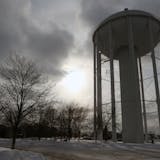A 2014 book written by local preservationist Robert Roscoe gives a detailed account of how a group of residents in Minneapolis' Seward Neighborhood saved two-block-long Milwaukee Avenue and its historic houses from demolition in the 1970s. While an excellent history of the early years of historic preservation, the book — and Milwaukee Avenue itself — has renewed relevance today as cities struggle to maintain their aging infrastructure and extensive road networks.
When Milwaukee Avenue became a "Planned Residential District" in the 1970s, the city closed the street to cars, and the homeowners' association took responsibility for the design and maintenance of the common. Walk down that avenue today and you will find a quiet, tree-shaded, pedestrian corridor, lined with front porches and featuring a playground and benches, with shared parking lots for residents and visitors and half the residents without an alley.
You will also see a possible future for many streets in the city.
Most blocks in Minneapolis — and St. Paul — have alleys for garages and trash removal, which leaves the streets for visitor parking and extra car storage. That represents a convenience for the property owners on these streets, but it ignores the fact that most municipalities do not have enough money to pay for the maintenance and repair of our roads.
Gasoline taxes, for example, go toward state and federal highways, not local roads. And according to a recent study by the Tax Foundation, fuel taxes and other tolls and user fees pay, on average nationwide, only half of what it costs to build and maintain our road system.
In Minnesota, gas taxes cover only 42 percent of the cost, placing us in 32nd place in the U.S. Most of the rest of our spending on roads comes from general tax revenues, competing with all of the other demands on public funds. Meanwhile, the new Republican majority in the Minnesota House of Representatives has pledged to invest more in our roads and bridges, although not necessarily increasing the gas tax, according to Majority Leader Kurt Daudt, which means that other areas of state spending will take a hit as a result.
While no one questions that our road infrastructure needs attention, too few have asked: How many roads do we need? Having fewer roads to maintain and repair will obviously make what limited public funds we have for this purpose go a lot further. Which brings us back to Milwaukee Avenue: It represents an alternative to our road-repair dilemma that deserves more attention.
What if other blocks in the city served by alleys did what the residents of Milwaukee Avenue accomplished: forming a homeowners' association, taking over the street in front of their houses, and converting the road to green space, play grounds, bike paths and pedestrian walks, with visitor parking at either end of the block? How many homeowners already have the equipment needed to clear snow, cut grass, and rake leaves in front of their property, and who wouldn't want more space in which children can play and nature can thrive?
![A black bear stopped after crossing Big Bay Road on Madeline Island, the largest of the Apostle Islands in Wisconsin, on Monday, May 31, 2021. ]](https://arc.stimg.co/startribunemedia/PWNYGIY3WTSWDBOGOYD775DPP4.jpg?&w=80&ar=1:1&fit=crop)


